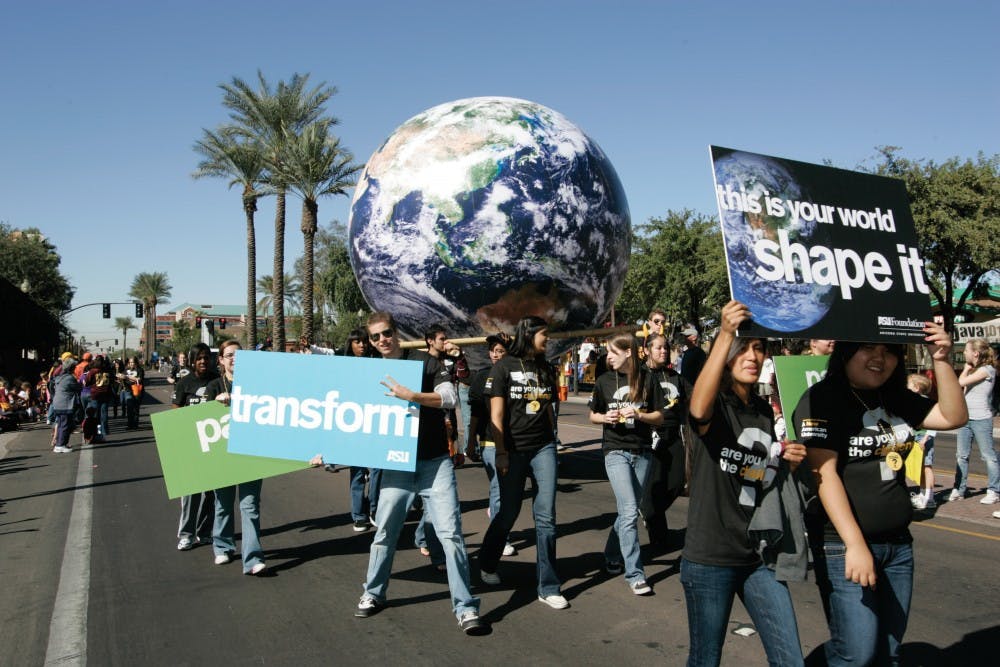ASU, despite being located in one of the least sustainable cities in the country, has been named sixth on the Sierra Club’s Cool Schools list, a commendation given to the most sustainable universities in the country. This ranking is a five-spot increase from last year when ASU came in 11th.
The University's sustainability metrics back up the listing — 12 percent of the university is run on renewable power, a number Michael Dalrymple, director of ASU’s sustainability practices, said is expected to increase by nearly 150 percent next year.
Other sustainable recognitions ASU has received include The League of American Bicyclist's gold-certification as a bike-friendly campus and the downtown Phoenix campus is bronze-certified. Tempe’s water usage has also dropped nearly 7 percent per capita over the past four years, according to a 2015 report from the Arizona Republic.
The Sierra Club’s ranking system is based on different criteria including energy, innovation and waste and water management. The University wasn't ranked as unilaterally perfect — it did poorly in purchasing sustainable goods, but it earned a full score in innovation and scored near the top in sustainable planning.
Many of these changes can be credited to the University’s Julie Ann Wrigley Global Institute of Sustainability, which is now celebrating 10 years of operation.
The first of its kind at the time, the sustainability school has overseen many of the sustainable changes ASU has undergone over the past decade.
Michael Dalrymple said the leadership at the University is a major key to sustainable progress.
“I think as far as ASU goes, it’s really more of a cultural and leadership situation," he said. "It only makes sense that we’re a leader in solar. President Crow is a visionary in a lot of ways; sustainability is one of them. He’s recognized the need for sustainability here.”
One of the sustainability school’s biggest goals is to get the ASU community aware of sustainable practices, Dalrymple said.
“We have to continue to innovate and expand our impact while ensuring we don’t inverse environmental impact."
This goes beyond creating new sustainable technology and creating long-term change comes from getting people to change their habits, he said.
“Early on, people had this idea that technology was going to solve everything,” he said. “But technology is only one tool, and as people have learned in international development, you can’t just take tractors to a developing country and suddenly they become prosperous. A big piece of this is societal behavior."
Combatting this problem won't be easy, but new “seeds of sustainability” courses will be added to each ASU 101 course to increase student awareness of sustainability on campus.
ASU has also implemented different programs to encourage water consumption and saving food, like the Strive for Five initiative, which encourages students to limit their showers to five minutes.
Working with the community is a top priority for the sustainability school, Anne Reichman, program manager of the school’s Sustainable Cities Network, which does outreach to the cities neighboring the University, said.
"(What makes us different) is getting cities involves with the research and grants,” Reichman said. “(Cities) can tell researchers what their needs are. Sometimes science isn’t translated. Just through involvement, we transform how cities approach sustainable practices.”
Reichman said programs within the Sustainable Cities Network such as the Low Impact Development Toolkit, which focuses on proper stormwater management, represent the potential of the sustainability school.
Sustainability doesn’t come without challenges. Sometimes calculations are wrong or plans fall through. But Sustainability Project Manager Corey Hawkey said these challenges drive most change.
“We have to continue to innovate and expand our impact while ensuring we don’t inverse environmental impact," Hawkey said. “And that’s a challenge, but challenge drives innovation, and complicated challenges require creative solutions.”
Reach the reporter at Emmillma@asu.edu or follow @Millmania1 on Twitter.
Like The State Press on Facebook and follow @statepress on Twitter.




